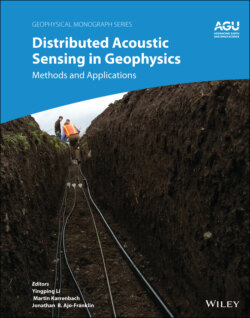Читать книгу Distributed Acoustic Sensing in Geophysics - Группа авторов - Страница 43
2.4. ACQUISITION PARAMETER SELECTION 2.4.1. Gauge Length
ОглавлениеFor DAS data acquisition, gauge length is among the most important choices to make. Gauge length imparts a wavenumber spectrum response that acts like an array of closely spaced single sensors. A longer gauge length decreases the usable frequency spectrum of the seismic signal; however, a long gauge length provides a better SNR because of the cancellation of random noise over the length of the gauge. Actually, the SNR, with respect to ambient (white) noise, increases as the square root of the gauge length.
Gauge length imparts notches (i.e., zeros) in the wavenumber domain according to sinc(kG), where k is the wavenumber and G is the gauge length; notch locations are at k = n/G, where n is the (integer) order of the notch. Because k = 2πf/c, where f is frequency and c is the apparent wave velocity, the effect of these notches depends on both frequency and apparent velocity of each wave in the seismic data.
The solid black lines in Figure 2.3 (top) show the locations of the first notch as a function of gauge length (horizontal axis) and frequency (vertical axis). Each line is associated with a specific apparent velocity that is labeled next to it, and the corresponding −20 dB point for each apparent velocity is represented by the dotted line. The area between the notch and the −20 dB point is grayed out. Looking at a 15 m gauge length, for a 500 m/s wave, the first spectral notch is located at 33 Hz, and the −20 dB point is located at 30.7 Hz. This means that, for all practical purposes, if a 15 m gauge is used, we can only effectively record waves traveling 500 m/s below 30.7 Hz; likewise, looking at a wave traveling 1000 m/s, we can only effectively record frequencies below 61.4 Hz. For waves traveling at the speed of water (1500 m/s), we are limited to frequencies under 92 Hz; however, if a 40 m gauge is used, the high frequency limits for waves traveling 500, 1000, 1500, 2000, and 2500 m/s are 11.5, 23.0, 34.5, 46.0, and 57.5 Hz, respectively.
Figure 2.3 (Top) Location of first spectral notch for a range of gauge lengths; solid black line represents the spectral notch associated with the labeled velocity, and the dotted line represents the corresponding −20 dB point. (Bottom) Relative signal‐to‐noise improvement using different gauge lengths compared to a 5 m gauge.
Two trends are easily observed: (1) larger gauge lengths can be used if the apparent velocities of interest are large, and (2) spectral notches are not as limiting on the upper frequencies for small gauges. It might appear that the conclusion should be to always use a small gauge length; but, as previously mentioned, the SNR improves as the gauge length increases (Figure 2.3, bottom). The vertical axis shows the SNR improvement as compared to a 5 m gauge, in dB; thus, the improvement using a 15 m gauge is 4.8 dB, while the 40 m gauge provides 9 dB improvement. Therefore, the goal is to use as large a gauge length as possible without damaging the desired frequency content of the seismic waves being recorded.
For earthquake‐monitoring applications where the frequency content is typically much less than 2 Hz, the notches will not affect the recorded spectrum, and thus a long gauge is appropriate. For a Gulf of Mexico deepwater VSP, it could be that seismic energy reflecting from the reservoir has a maximum frequency content of 20 Hz because of the earth’s attenuation. Figure 2.3 (top) shows that any gauge length from 5 to 50 m can capture all seismic waves faster than 1000 m/s; thus, it might be worth the added SNR benefits to use a long gauge. However, if, instead, the application is shallow and unconsolidated formations with extremely slow P‐ and S‐waves, and a high‐frequency source is used, then an extremely short gauge should be used at the expense of SNR.
